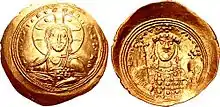Histamenon
Histamenon nomisma (griechisch: ἱστάμενον νόμισμα) war eine Bezeichnung für das Nomisma (standardmäßig 24 Karat oder Siliquae), die Entsprechung und Fortführung des Solidus, der römischen Goldmünze, im Byzantinischen Reich.

Es unterscheidet sich vom gleichzeitig herausgegebenen Tetarteron nomisma durch den Durchmesser und die Dicke der Münze.[1] Das Histamenon entwickelte sich ab der Regierungszeit von Nikophoros II. Phokas (963–969) zu einer größeren und schlankeren Münze, während ein sich entwickelnder Typus – das Tetarteron – kleiner, aber dafür dicker wurde, bei identischem Goldgehalt jedoch 1/12 weniger wog. Beide Münzen waren anfangs ikonographisch identisch, unterschieden sich ab der Regierungszeit von Konstantin VIII. (1025–28) aber auch bildlich voneinander.[2] Ab der Mitte des 11. Jahrhunderts entwerteten sich beide Münzen massiv und erreichten ihren Tiefpunkt während des ersten Jahrzehnts der Regierungszeit von Alexios I. Comnenus (1081–1118). Ursachen dieser Entwertung sind historisch umstritten.[3] Diese Entwicklung gipfelte in einer Münzreform, wobei das Histamenon und das Tetarteron durch das Hyperpyron ersetzt wurden.[4] Die historischen Quellen für die Existenz beider Münzen sind neben Briefen über Geldforderungen und archäologischen Quellen unter anderem die Chronisten Johannes Zonaras und Georgios Kedrenos.[5]
Literatur
- Philip Grierson: The debasement of the Bezant in the eleventh century. In: Byzantinische Zeitschrift 47, 1954, S. 379–394.
- Michael F. Hendy: Light weight Solidi, Tetartera, and the book of the prefect. In: Byzantinische Zeitschrift 65, 1972, S. 57–80.
- Philip Grierson: Byzantine coins. Methuen u. a., London u. a., 1982, ISBN 0-416-71360-2.
- Philip Grierson: Histamenon. In: The Oxford Dictionary of Byzantium. Oxford University Press, New York/Oxford 1991, ISBN 0-19-504652-8, S. 936.
- Cécile Morrisson: Coinage and Money in Byzantine Typika. In: Dumbarton Oaks Papers 56, 2002, S. 263–275.
- Costas Kaplanis: The Debasement of the Dollar of the Middle Ages. In: The Journal of Economic History 63, 2003, S. 768–801.
- Andreas Urs Sommer: Die Münzen des byzantinischen Reiches 491–1453. Mit einem Anhang: Die Münzen des Reiches von Trapezunt. Battenberg Verlag, Regenstauf 2010, ISBN 978-3-86646-061-4.
- Sophie Lavenne: Histamenon et tetarteron: la politique monétaire des empereurs macédoniens entre Nicéphore II (963–969) et Michel IV (1034–1041) (= Bibliothèque de Byzantion 11). Universa, Brüssel 2010, ISBN 90-6281-009-8.
Einzelnachweise
- Philip Grierson: Histamenon. In: The Oxford Dictionary of Byzantium. Oxford University Press, New York/Oxford 1991, ISBN 0-19-504652-8, S. 936.
- Michael F. Hendy: Light weight SOLIDI, TETARTERA, and the book of zhe prefect. In: Byzantinische Zeitschrift 65, 1972, S. 63, 64.
- Costas Kaplanis: The Debasement of the Dollar of the Middle Ages In: The Journal of Economic History 63, 2003, S. 771–774.
- Philip Grierson: The debasement of the Bezant in the eleventh century. In: Byzantinische Zeitschrift 47, 1954, S. 386.
- M. F. Hendy, Light weight Solidi, Tetartera, and the book of the prefect. In: Byzantinische Zeitschrift 65, 1972, S. 63–69.